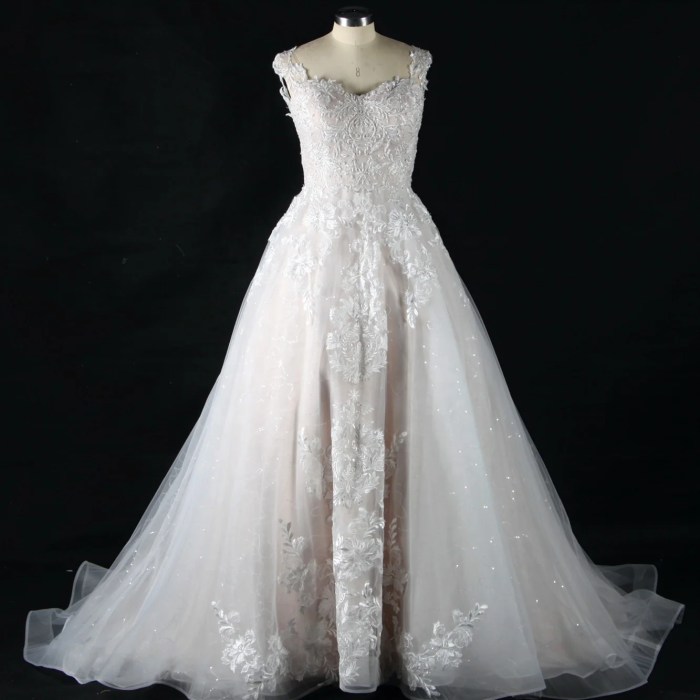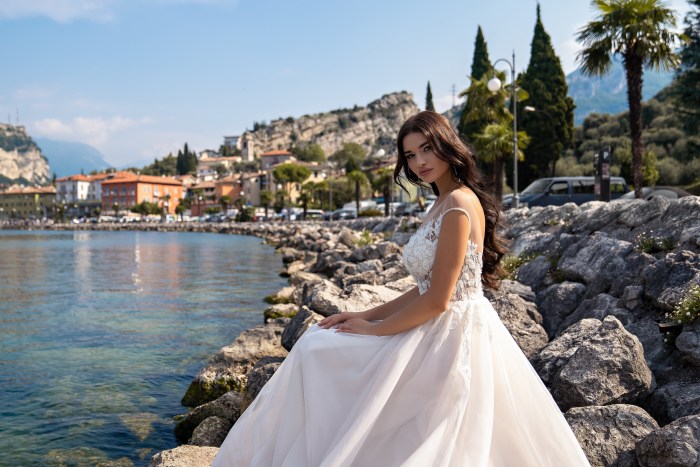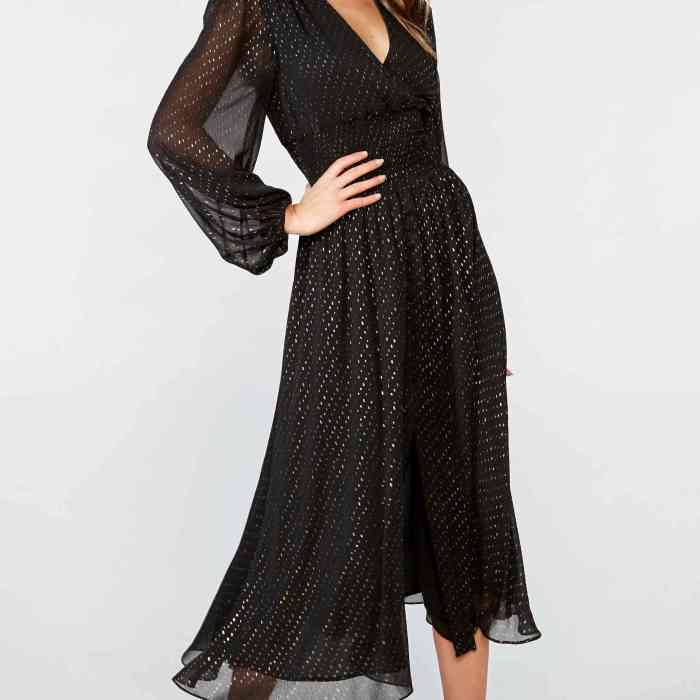Islamic Groom Wedding Attire: A Comprehensive Guide: Islamic Groom Wedding Dress
Islamic groom wedding dress – Islamic groom wedding attire reflects a rich tapestry of cultural traditions and evolving styles. This guide explores the diverse elements shaping contemporary Islamic groom fashion, from traditional influences to modern interpretations, offering insights into fabrics, colors, accessories, and design trends.
Styles and Trends in Islamic Groom Wedding Attire
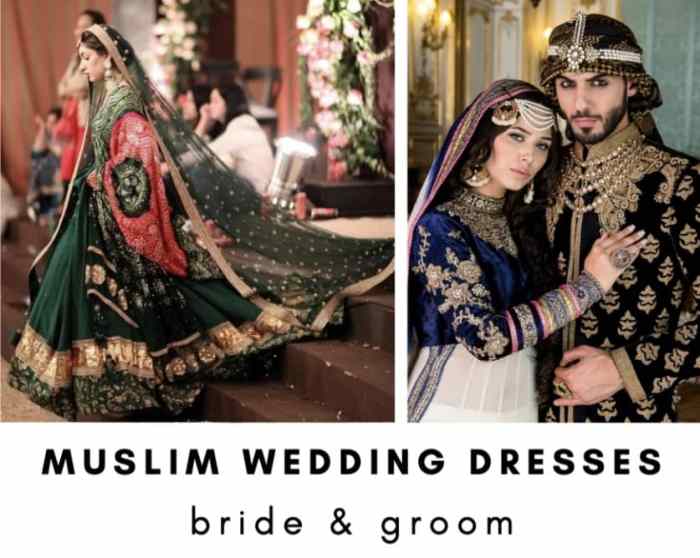
Source: getethnic.com
Over the past decade, Islamic groom wedding attire has witnessed a fascinating evolution. While traditional elements remain central, a blend of modern sensibilities and global influences has resulted in a diverse range of styles. This evolution reflects a growing awareness of personal style within the framework of religious modesty.
Three distinct regional variations exemplify this diversity:
- South Asian Attire: Often characterized by richly embroidered sherwanis (long coats), paired with churidar pajamas (tight-fitting trousers) and embellished safa (turban). Intricate gold embroidery, heavy brocade fabrics, and vibrant jewel tones are common features.
- Middle Eastern Attire: This style frequently incorporates thawbs (long, loose-fitting robes), often made of luxurious fabrics like silk or brocade, sometimes adorned with subtle embroidery or embellishments. The use of color varies widely, with deep jewel tones being popular.
- Southeast Asian Attire: This region showcases a range of styles, often influenced by local traditions. Batik-printed shirts and trousers, paired with songkok (a traditional cap), are common. The use of natural fabrics and earthy tones is prevalent.
Contemporary Islamic groom attire often balances traditional and modern elements. For instance, a modern interpretation might involve a tailored sherwani in a contemporary cut, paired with slim-fit trousers and modern accessories. The choice often reflects a personal preference for a balance between heritage and contemporary style.
Three design examples illustrate this blend:
- Classic Elegance: A deep navy blue silk sherwani with subtle gold embroidery, paired with ivory churidar pajamas and a matching safa. The simple elegance highlights the quality of the fabric and the craftsmanship of the embroidery.
- Modern Minimalism: A tailored, charcoal grey velvet thawb with minimal silver detailing, paired with tailored trousers and simple leather loafers. This design emphasizes clean lines and a sophisticated aesthetic.
- Fusion Style: A bespoke batik-printed shirt with a modern cut, paired with tailored trousers and a stylish songkok. This exemplifies a contemporary take on traditional Southeast Asian style.
Fabric Choices and Embellishments
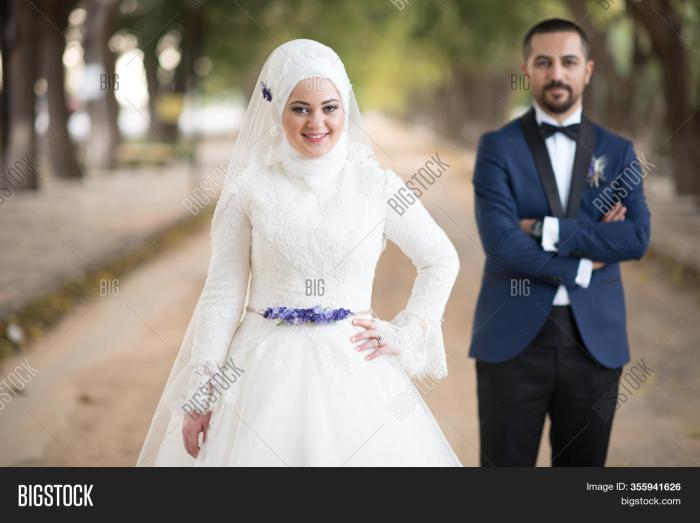
Source: bigstockphoto.com
The choice of fabric and embellishments holds significant symbolic and cultural value in Islamic groom attire. Fabrics often reflect status, taste, and regional traditions.
Silk, brocade, and velvet are commonly used, each carrying its own symbolism. Silk, often associated with luxury and refinement, represents elegance and sophistication. Brocade, with its intricate woven patterns, signifies richness and heritage. Velvet, with its plush texture, denotes opulence and warmth.
Embellishment techniques, such as embroidery, beading, and gold leaf, enhance the visual appeal and cultural significance of the attire. Intricate embroidery patterns often tell stories or reflect cultural motifs, while beading adds sparkle and texture. Gold leaf, symbolizing prosperity and good fortune, is a common choice for embellishment.
| Fabric | Properties | Suitability | Cultural Relevance |
|---|---|---|---|
| Silk | Luxurious, smooth, drapes well | Formal events, warmer climates | Represents elegance and refinement |
| Brocade | Rich, textured, intricate patterns | Formal events, traditional styles | Signifies richness and heritage |
| Velvet | Plush, luxurious, warm | Cooler climates, evening events | Denotes opulence and warmth |
| Linen | Lightweight, breathable, durable | Summer weddings, casual styles | Represents simplicity and comfort |
| Cotton | Soft, breathable, comfortable | Casual or semi-formal events | Versatile and widely accessible |
Embellishments can reflect personal style and cultural heritage. For example, intricate floral embroidery might represent a love for nature, while geometric patterns could symbolize a connection to specific cultural traditions. The use of specific colors in the embellishments can also add another layer of cultural significance.
Color Palettes and Their Significance
Color choices in Islamic weddings hold deep cultural significance, often reflecting joy, prosperity, and spiritual meaning. The groom’s attire plays a vital role in this color symbolism, complementing the bride’s attire while maintaining modesty.
Certain colors, such as deep blues and greens, are often associated with peace and tranquility, while rich golds and reds symbolize prosperity and celebration. The selection should be sensitive to the cultural context and the season of the wedding.
Color choices should complement the bride’s attire while maintaining Islamic principles of modesty. This often involves avoiding overly flashy or revealing colors, opting instead for rich, elegant hues that enhance the overall aesthetic without drawing undue attention.
- Classic Elegance: Deep navy blue, gold accents. Suitable for formal winter weddings.
- Summer Sophistication: Soft ivory, muted gold embroidery. Appropriate for summer weddings, reflecting a sense of light and airy elegance.
- Rich Tradition: Deep emerald green, gold accents. Suitable for traditional weddings, symbolizing prosperity and good fortune.
- Modern Minimalism: Charcoal grey, silver accents. Suitable for modern weddings, reflecting a sense of understated elegance.
Accessories and Complementary Items, Islamic groom wedding dress
Accessories play a crucial role in completing the Islamic groom’s wedding look, adding personality and cultural depth. Headwear, footwear, and jewelry are key elements.
Choosing the perfect Islamic groom wedding dress involves careful consideration of both style and modesty. The fit and silhouette are paramount, and often require seamless undergarments to achieve a smooth, refined look. For a truly polished appearance, consider using invisible underwear for wedding dress to ensure a flawless finish under the thobe or sherwani. This attention to detail elevates the overall presentation, reflecting the significance of the occasion.
Traditional headwear, such as the safa (turban) or songkok (cap), adds a touch of cultural identity. Footwear choices range from traditional embroidered shoes to modern loafers, reflecting personal style. Jewelry choices, while often understated, can include cufflinks, rings, or a watch, adding subtle details.
The choice of accessories can enhance the overall aesthetic and reflect personal style. A modern groom might opt for minimalist accessories, while a more traditional approach might involve richer, more elaborate choices.
- Traditional Ensemble: Embroidered safa, intricately designed leather shoes, gold cufflinks. This ensemble enhances a classic sherwani.
- Modern Minimalist: Simple leather loafers, a sophisticated wristwatch, understated cufflinks. This complements a tailored thawb.
- Fusion Style: Stylish songkok, elegant leather sandals, subtle silver ring. This completes a modern batik-printed outfit.
Modern Interpretations and Contemporary Designs
Emerging trends in Islamic groom wedding attire demonstrate a growing interest in modern interpretations of traditional styles. Designers are incorporating contemporary elements while retaining cultural authenticity.
Social media and fashion influencers play a significant role in shaping trends. Online platforms showcase diverse styles, inspiring grooms to explore unique and personalized looks. This leads to a wider acceptance of modern adaptations of traditional attire.
A fictional example of a modern Islamic groom’s wedding outfit might include a tailored, slim-fit sherwani in a deep teal silk, featuring subtle geometric embroidery inspired by traditional Islamic patterns. This would be paired with tailored trousers, minimalist leather shoes, and a simple, modern wristwatch. The design combines contemporary tailoring with subtle cultural references, creating a unique and stylish look.
FAQ Section
What is a typical budget for an Islamic groom’s wedding attire?
The cost varies greatly depending on the fabric, embellishments, and designer. Expect a range from a few hundred to several thousand dollars.
Where can I find Islamic groom wedding attire?
Many options exist, including specialized boutiques, online retailers, and even bespoke tailors specializing in Islamic wedding attire.
How far in advance should I start planning my Islamic groom’s attire?
Ideally, begin at least six months prior to allow for tailoring, alterations, and potential delays.
Can I incorporate Western elements into my Islamic groom’s attire?
Yes, many grooms blend traditional and modern elements to create a unique and personalized style, maintaining modesty and cultural sensitivity.

